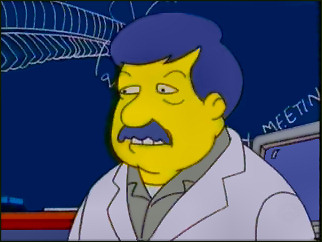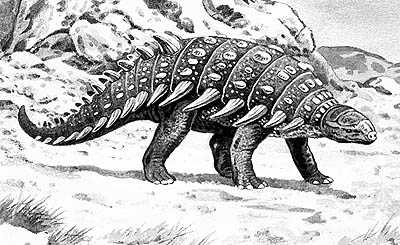For the past few months, I have been stewing over what kind of paleontological articles I could write for my blog. It’s easy to write and talk about comics, cartoons, and video games as you rely on experience and personal opinion. Scientific articles, however, are more difficult for me as not only do they have to be interesting to the reader but they also have to be more objective and lean more heavy on up-to-date resources. However, while I was sitting in the back row of the Introduction to Biology course (part of my requirement for being a lab TA), I was struck with an idea that was brought about my cool and collect professor.
In paleontology (and other sciences as well but I’m more attuned to the paleo ones) there is a large amount of misconceptions that many people believe to be true. Some misconceptions are more innocently ignorant (pterodactyls and mosasaurs are dinosaurs) while others deceit even fossil enthusiasts today. These misconceptions still hang around because they were long believed to be true, were over simplified, or were romanticized to the point that they have to be correct because it sounds so perfect.
Today, I adduce to you a fine example of a romanticized misconception.
Meet Megaloceros giganteus, a large mammalian deer that lived during the Pleistocene. It’s also known as the “Irish Elk.”
And already, right from the get-go, we see two misconceptions that lead you astray from what this beast represents.
Irish Elk
The funny thing about Megaloceros’ common name is how plain wrong it is; Megaloceros is not exclusively found in Ireland and it is a deer not an elk. First off, it can be found throughout Europe, North Africa, and well into western Asia (Lister 1994) so it has quite a diverse range. Its association towards Ireland stems from its initial discovery there as well as the plentiful amount of specimens preserved in the Irish Bogs (http://www.ucmp.berkeley.edu/mammal/artio/irishelk.html and Gould 1977). Irish poet Seamus Heaney even mentioned Megaloceros in his poem “Bogland” which is a short poem about the bogs of Ireland.

Map from Lister (1994).
But being geographically confused seems trifling when many people assume that Megaloceros is an elk. This doesn’t seem like a big deal until you realize that people in Eurasia use the term “elk” to refer to the animal that North American people refer as “moose.” And THAT…is where the confusion lies. Megaloceros is not a moose it’s a deer. It was originally confused to be a moose because only moose were known at the time to have antlers that came even close to the size of Megaloceros (Gould 1977).
This moose-association was eventually taken down once enough viable specimens could be used for anatomical comparison. Even the advent of genetic technology, which has the habit of shaking phylogenetic trees hard, did nothing to subvert this new-found truth and only enhanced Megaloceros’ position by placing it as a sister taxon to the fallow deer (Lister et al. 2005 and Hughes et al. 2006).
As such, many scientists nowadays call Megaloceros the “Giant Deer.” And though I think this name does not sound as majestic as “Irish Elk,” it is nonetheless 100% more correct and should be used more often.
But now let us get to the heart of the matter of the Giant Misconception for our Giant Deer.
You may be familiar with the Giant Deer in high school biological textbooks or as an example for Hardy-Weinberg sexual selection. Similar to peacocks, males had large antlers to showcase their sexy fitness. A display of dominance will win over any lucky gal and together, they can make adorable, small Giant Deer.
But.
For a long time, the prevailing hypothesis behind the demise of the Giant Deer was that their antlers were so huge that eventually their size drove them to extinction. Their constant selection for bigger antlers meant they became too unwieldy, too energy costly, or just plain too heavy for the males to support. Basically, the Giant Deer became too sexy.
This “Too Sexy for My Antlers” hypothesis was accepted as truth until the mid-20th century when paleontologists discredited it as being farfetched and countered that the antlers were the right size relative to the Giant Deer’s body (Gould 1977). However, no one bothered to test this new hypothesis out! This was until famous paleontologist Stephen Jay Gould stepped in and experimented with the hypothesis himself in 1973. In his simple experiment, he analyzed modern deer specimens and compared the size of their antlers relative to their shoulder height. He then compared his data to that of the Giant Deer. What he found was that the antlers were not as dangerously large as everyone once thought they were. In fact, they were at the expected level if you were to have a modern day deer of that size.

Photograph of Stephen Jay Gould from The Simpsons.
The importance of Gould’s discovery goes farther than determining the antler size of an extinct deer. It discredited a long dead notion that continued to propagate the “Too Sexy for My Antlers” hypothesis. There was this “theory” that existed in the late 1800s and early 1900s called orthogenesis that some scientists used to counter Darwin’s Theory of Evolution (and btw, before I forget, happy early birthday Charles).
Instead of Natural Selection, species evolve in a direct, linear path. Species are evolving to a final end product that they are destined for. As such, some orthogenesis scientists used the Giant Deer as an example of evolution that went too extreme and killed the species. Taken from Gould (1977), orthogenesis supporter and paleontologist R. S. Lull said “Natural selection will not account for overspecialization, for it is manifest that, while an organ can be brought to the point of perfection by selection, it would never be carried to a condition where it is an actual menace to survival…[as in] the great branching antlers of the extinct Irish deer.”
Gould’s experiment was the final nail in a long-forgotten, already decaying coffin. It was evidence that took down a dying idea that stubbornly eked out a living for many decades. And yet while the scientific community had learned the new ideas and rejected the old ones, I would beg to differ that the public had been so quick to adapt as well.
Even I, who was a paleo-nut in high school, assumed that the Irish Elk died out due to its impressive antlers. No one had bothered to correct me that it had a diverse geographical range, or that it was technically a deer, or that its antlers were the right size until I was a graduate student. I would even go far as to argue that I was unknowingly accepting orthogenetic ideas while learning about biology and evolution.
I should try to get off my soap box before I become too preachy so I’ll end with this. While writing this article, I was not aware of the orthogenesis hypothesis as I was never taught it before, even with all the biological courses I had taken. I was taught Lamarckism and other discredited theories but never orthogenesis. However, I think orthogenesis should be taught in basic biological courses as blooming scientists can learn what evolution is and is not. They can learn why scientists thought orthogenesis is true and why it was ultimately rejected. Learning about it can give a better understanding on how life works and why they should not accept this dead hypothesis.
And hey, if teachers were to educate their students about orthogenesis, students might even learn more about the Giant Deer and how, despite its outlandish appearance, it did not go extinct from being too sexy.
If you are interested in the crazy history of the Giant Deer, I recommend you to check out Gould’s “The Misnamed Mistreated and Misunderstood Irish Elk.” It’s an enthralling read and greatly expands many of the concepts information I touched upon in this article.
Bibliography
Gould, Stephen Jay. “Positive allometry of antlers in the “Irish elk”, Megaloceros giganteus.” (1973): 375-376.
Gould, Stephen Jay. “MISNAMED, MISTREATED, AND MISUNDERSTOOD IRISH-ELK.” Natural History 82.3 (1977): 10.
Hughes, Sandrine, et al. “Molecular phylogeny of the extinct giant deer, Megaloceros giganteus.” Molecular phylogenetics and evolution 40.1 (2006): 285-291.
Lister, Adrian M. “The evolution of the giant deer, Megaloceros giganteus (Blumenbach).” Zoological Journal of the Linnean Society 112.1‐2 (1994): 65-100.
Lister, A. M., et al. “The phylogenetic position of the ‘giant deer’Megaloceros giganteus.” Nature 438.7069 (2005): 850-853.













